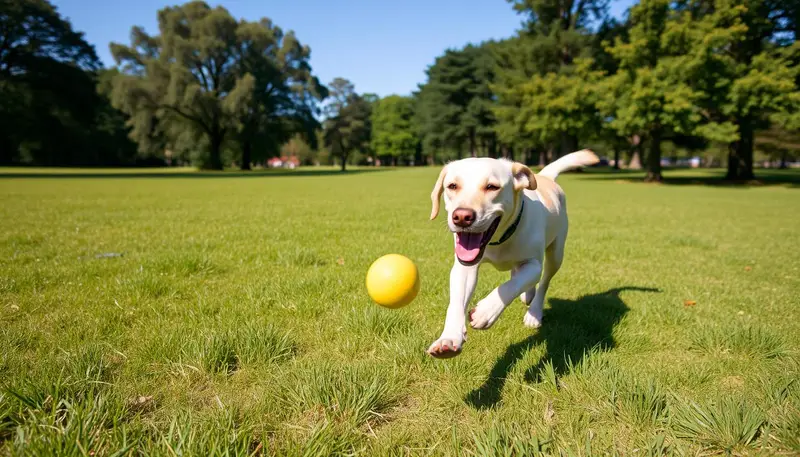How to avoid over-exercising your Labrador Retriever
Exercise is great for dogs, helping with their joints, heart health, and keeping them at a good weight. But, too much exercise can harm your Labrador Retriever. Dr. Robin Downing warns against too much, too soon, for overweight dogs. Signs of too much exercise include worn-out paw pads, sore muscles, and heat problems.
How much exercise your Labrador needs depends on their age, energy, and health. It’s important to know what’s right for your dog to keep them happy and healthy.
Key Takeaways
- Labrador Retrievers should avoid high-impact activities like jogging, jumping, and leaping, at least until their bones are fully grown.
- Too much exercise can cause joint problems and arthritis in big dogs.
- Good exercise plans mix cardio and strength training with rest days.
- Working with a vet is key to making sure your dog gets the right amount of exercise.
- Because of their face shape, Labradors can get heatstroke easily and need extra care in hot weather.
Understanding Your Labrador’s Exercise Needs and Limitations
Labrador Retrievers are known for their high energy and love for moving. Their exercise needs change based on age, health, and individual traits. Knowing these details is key to keeping your Labrador fit and healthy.
Physical Characteristics of Labradors
Labrador Retrievers are strong and athletic, built for lots of exercise. They have a sturdy body and a thick coat that keeps them warm and dry. They love swimming, fetching, and hiking.
Age-Related Exercise Considerations
As Labradors get older, their exercise needs change. Puppies need gentle exercise to protect their growing bones and joints. Older Labradors or those with health issues need easier exercise to avoid injury.
Impact of Health Conditions on Exercise Capacity
Labradors are usually healthy, but some conditions can affect their ability to exercise. Breathing can be hard for them during intense activities. Also, hot weather makes exercise harder on their heart and lungs.
To keep your Labrador fit and safe, tailor their exercise to their needs and the environment. Talking to your vet can help create a good exercise plan for your Labrador.

“Gradually introducing running activities is recommended, considering factors like age and overall health. Swimming is a low-impact exercise that can benefit Labradors, specially those with joint issues.”
How to avoid over-exercising your Labrador Retriever
Labrador Retrievers are very active and need a balanced exercise routine. Too much exercise can harm their health. It’s important to find the right balance.
Start your Labrador’s exercise slowly and carefully. Healthy adult Labradors do well with 30 minutes of play each day. Try to avoid exercising them when it’s too hot, and choose cooler times instead.
Don’t let your Labrador exercise for more than an hour a day. Watch how many people are playing with them and for how long. Make sure the activities are fun for your Labrador, like running or swimming.
Every Labrador is different, based on their age, energy, and health. Keep an eye on how they react to exercise. Adjust their routine as needed to keep them safe and healthy.

By following these tips, you can keep your Labrador healthy and happy. Always talk to your vet if you’re unsure about your Labrador’s exercise needs.
Recognizing Signs of Exercise Exhaustion in Labs
As a responsible Labrador Retriever owner, it’s crucial to know the signs of exercise exhaustion in your beloved companion. Overexertion can lead to serious health consequences. Understanding the physical warning signs, behavioral indicators, and emergency signals is essential to ensuring your Lab’s wellbeing.
Physical Warning Signs
Keep a close eye out for excessive panting, worn or torn paw pads, muscle soreness and stiffness, and difficulty moving. These physical indicators suggest your Lab has pushed their limits and may be nearing a state of over-exercise.
Behavioral Indicators
Behavioral cues like reluctance to continue the exercise, refusing to climb stairs, or hesitation to jump can all signify that your Labrador has reached their threshold. Pay attention to these subtle behavioral changes to prevent further strain.
Emergency Warning Signals
The most serious warning signs include collapse, signs of heat exhaustion or heatstroke (body temperature above 106°F), dehydration, and breathing difficulties. Dr. Liss cautions that symptoms like panting, fatigue, and collapsing may also indicate other underlying health issues such as heart disease. If you observe any of these emergency signals, consult a veterinarian immediately.

